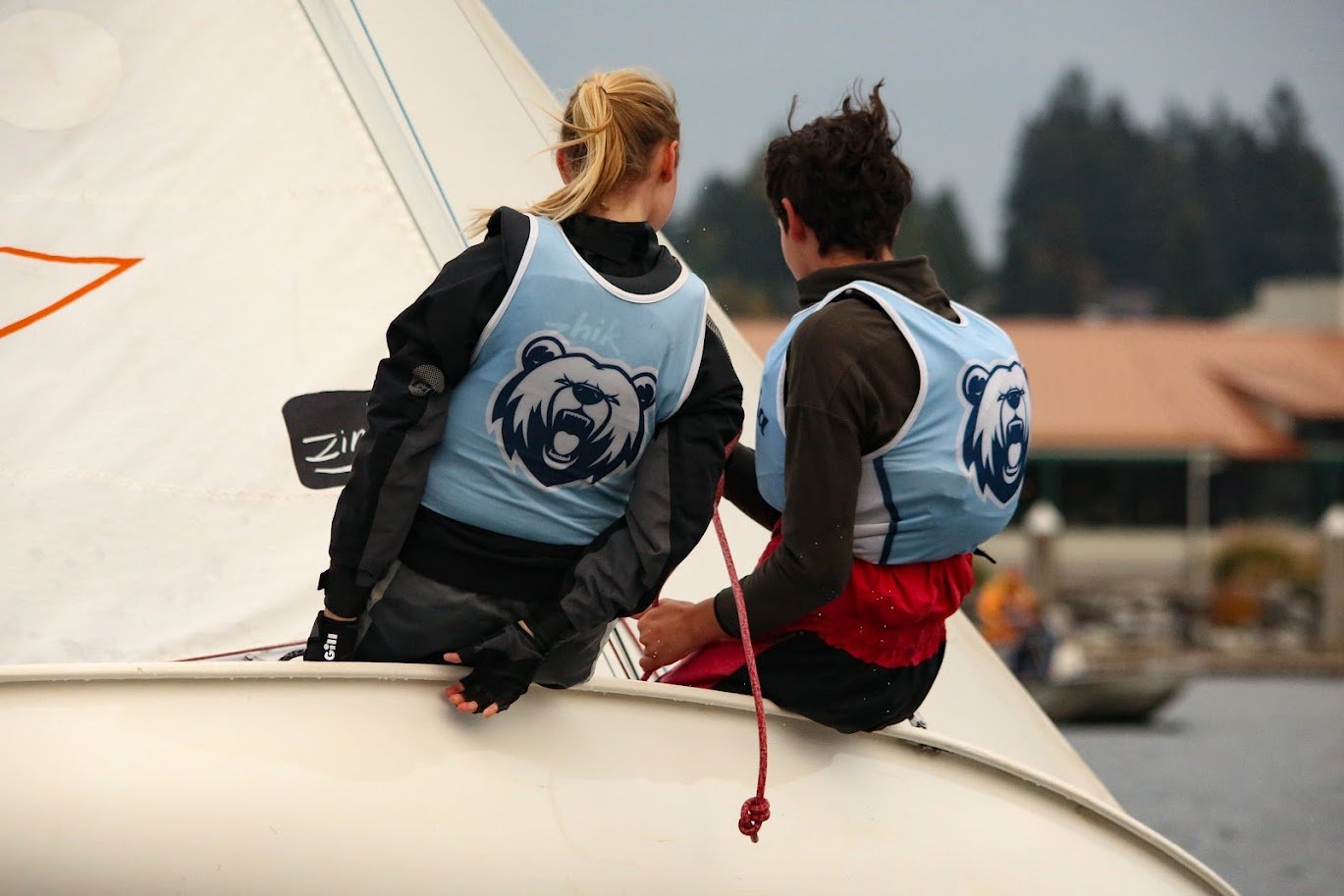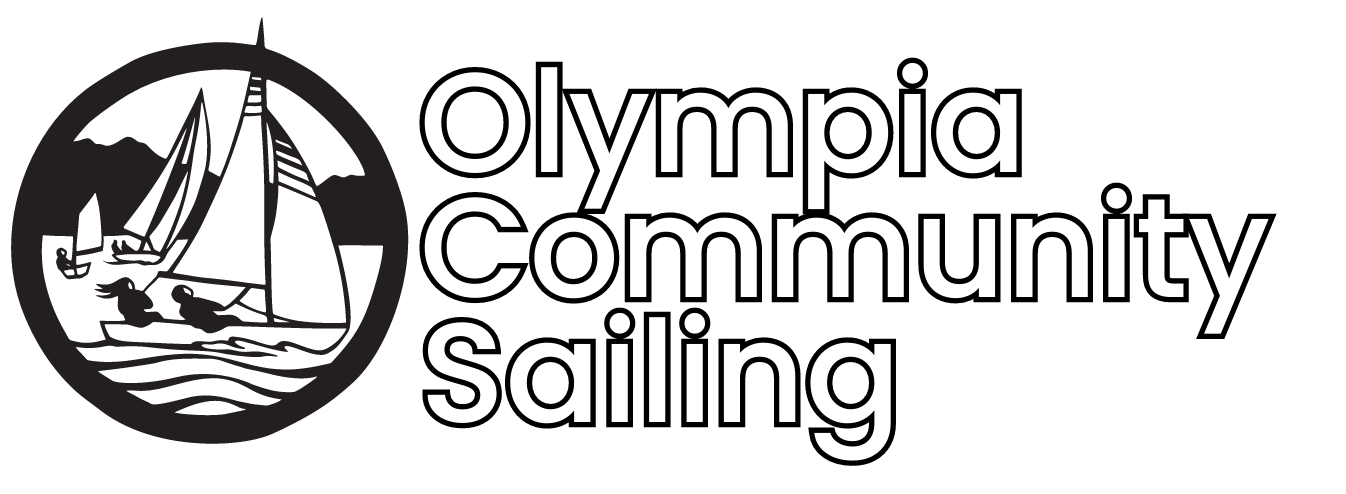
High School Sailing
High School Sailing is a nation-wide sport, and one of the only truly co-ed sports for young men and women to compete equally together. In High School Sailing sailors practice weekly, combine scores with teammates to win events, travel all over the the NW to competitions, and can use High School experience to seek opportunities to sail at the Collegiate level.
Our High School Sailing Team is a nationally-ranked program, with many awards and accolades. OCS alumni are at Coast Guard Academy, Tufts, Cal Poly, Duke, George Washington, USC, UW, Western, and many more elite Collegiate programs. At OCS, your sailor will gain valuable memories, life skills, and valuable experiences to benefit them in college and beyond.
High School Sailing is unique, in that all local high school teams practice together. While Olympia, Capital, Black Hills, North Thurston, and Tumwater High School Teams all practice and travel together, teams compete at regattas under their school’s name.
-
Sailors in the 8th grade and above that attend any Thurston County high school can join our High School Team.
Any sailor regardless of experience (or lack thereof) can attend tryouts and be seeded onto one of our three teams.
Experienced sailors can try out for the Varsity team late summer before fall season. It’s all about attitude. If you seek challenges; value athleticism; see mistakes as learning opportunities; enjoy camaraderie, team work, and pursuing common goals - you could be an OCS High School sailor.
OCS currently supports teams from the following high schools: Avanti, Black Hills, Capital, North Thurston, Olympia, Tumwater, and Yelm.
-
You can still participate!
Competition rules allow sailors to compete on mixed teams (teams made up of sailors from different high schools) in certain regattas. Sailors on a mixed team cannot compete at District Qualifiers or qualify for Nationals, but are able to compete at all other events.
-
High School Sailing is a two season sport: fall and spring.
The fall season typically runs from September through the first week in November, with tryouts occurring in August. Spring season runs March through May.
-
High School Sailing is govered by ISSA and is not a WIAA sanctioned sport. As such, eligibility rules may differ from other high school sports.
ISSA rules dictate that sailors must compete for the school they attend: no exceptions. Home-schooled and alternative-schooled youth sail for the team of the high school they would attend based on home address.
Read the Procedural Rules here: https://hssailing.org/documents/ISSA-PR-2021-2024.pdf
-
At OCS, all High School sailors practice and travel to competitions together. At regattas, they are split into teams of four that represent their specific high school. Sailors that go to a school with fewer than four sailors can sail on a “mixed team” with sailors from other high schools.
At regattas, sailors are often split into different fleets based on skill level. JV sailors will often sail in Bronze or Silver Fleet. Varsity sailors usually sail in Gold Fleet, but may sail in Silver as well.
A “team” consists of four sailors and one boat. Two individuals will sail the boat for two races, while their other pair waits on shore. They then rotate so the on-shore pair sails for two races. This continues for the course of the regatta, and the scores from both pairs are combined for the team’s final score.
-
What Do Regattas Look Like?
Regattas are typically two day events. Sailors rotate between sailing on the water and hanging out on shore with their teammates.Most regattas have two “fleets” that generally correspond to a sailor’s skill level: Gold and Silver. A large event may add a third “fleet” (Bronze). Typically, a school is allowed to have one “team” in each fleet, though exceptions are frequently made to allow schools to have multiple “teams” in Silver or Bronze fleet. At Ranking, Qualifier, or Championship events, “mixed” teams (see Teams above) are only allowed to compete in Bronze or Silver fleet, meaning they are ineligible to qualify for National level events.
There are two different formats for High School Sailing racing: Fleet and Team Racing.
Fleet Racing
In Fleet Racing, a “team” consists of four sailors and one boat divided into two fleets: A and B. Two sailors (one skipper and one crew) will represent the team in A fleet and sail the boat for two races, while their B fleet teammates wait on shore. After two races, teammates switch, and the two teammates that were on shore will sail for two races in B fleet. This pattern will continue for the whole regatta. Depending on the number of sailors from any given school, a “team” may have additional sailors called “alternates” that rotate within the “team”. The scores of A fleet and B fleet are combined to result in the team’s final score.Team Racing
In Team Racing, a “team” consists of six sailors and three boats. These six sailors all sail at the same time against another “team” of six. The scores of each team’s three boats are all combined, and each boat is assigned points equal to their finishing position (1st = 1 point, 2nd = 2 points, etc.). Sailors work together to help their teammates get a better score. In Team Racing, it is possible to finish last in the race, but still win!The first day of the event there is typically not a specified end time (unless there is a planned dinner/social event). This is because we never know when the wind might fill in! Racing can go into the early evening if the wind fills in late, especially if it is a qualifier regatta. At the start of the day, Race Committee will often indicate their general plan for the day’s end at the Competitor’s Meeting, but all plans are subject to the wind. The second day of the event generally has a specified end time for the sailing portion, followed by awards and loading boats.
Equipment Transportation
Sailors and families work together to help transport sailboats to and from events. OCS will typically see 12-20 sailors attending an event, and will often transport three boats on a stacked trailer to the event. We do our best to rotate which family is transporting the trailer, so the burden is spread out.Regatta & Clinic Fees
Regatta fees are not covered as part of race team dues. Regattas typically have a small fee ranging from $5-20 per sailor, which covers the cost of running the event.Clinic fees tend to be higher as they hire advanced coaches to come and coach sailors. The sailor to coach ratio is quite high, and sailors are being coached for many hours.
Regatta Sign Up
OCS requires sailors to sign up for regattas internally, which indicates to us you plan to attend an event and want coaching at it.Signing up for a regatta does not guarantee you will get to attend. OCS works hard to bring every sailor that wants to go to every event, however some events have a number or skill cutoff. Sailors should register for every event they want to attend, regardless of whether they think they will be considered!
-
OCS hosts three High School Teams: Varsity, Junior Varsity, and Sea-Team.
Sailors from all area high schools practice together on each of our three teams. At competitions, sailors compete with teammates from the same school. Depending on the event, sailors from Sea-Team and JV may compete with teammates on Varsity.
OCS seeds our Sea-Team, JV, and Varsity teams like a traditional high school sport. Sailors are promoted to higher teams through a combination of higher skills, focused mindset, and maturity.
Interested in joining?
Email: coacherin@olympiacommunitysailing.org
-
National Championships
Fleet Race Nationals (Mallory Cup)
2022: 19th overall (San Diego, CA)
2021: 13th overall, 7th in A fleet (Cleveland, OH)
2019: 11th overall (Seattle, WA) (highest finish from NW school - EVER)
2018: 17th overall (Seabrook, TX)Team Race Nationals (Baker Cup)
2021: 12th overall (Miami, FL)
2019: 12th overall (Portland, ME)Women's National Invitational
2022: 7th overall (Mission Bay, CA)
2021: 4th overall (Mission Bay, CA)Keel Boat Nationals
2017: 10th overall (St. Petersburg, FL)
Single Hand Nationals (Cressy Cup)
2017: 14th overall (St. Petersburg, FL)
NW District Championships
Fleet Race Champs
2022: 2nd overall
2021: 1st overall
2019: 1st overall
2018: 1st overall
2017: 5th overallTeam Race Champs
2022: 2nd overall
2021: 1st overall
2019: 1st overall
2018: 2nd overallKeelboat Champs
2017: 1st overall
Singlehanded Champs
2017: 1st overall
Highly Competitive Regattas
Rose Bowl (Long Beach, CA)
Gold Fleet
2023: 22nd overall
2022: 21st overall
2021: 10th overall (highest finish from NW school - EVER)
2020: 18th overall
2019: 22nd overallSilver Fleet
2018: 4th overall
Awards
NWISA Sportspmanship Award
2016 (1st year team had more than 4 active sailors)
-
NW District Championship
Fleet Race Champs
2018: 4th overall
2017: 2nd in Silver Fleet
2016: 4th in Silver FleetWomen's Champs
2018: 1st overall
Highly Competitive Regattas
Rose Bowl (Long Beach, CA)
2018: 1st Place (Bronze Fleet)
PCISA Women's Invitational (San Diego, CA)
2018: 10th overall
The Capital Sailing Team was founded in 2016





